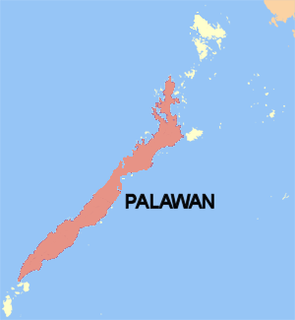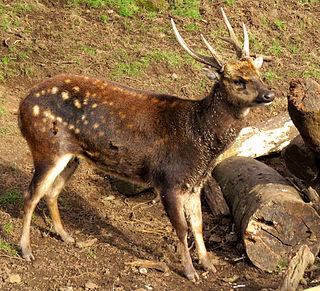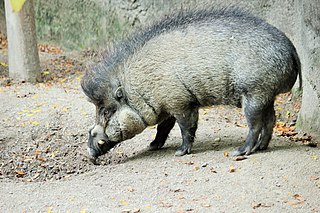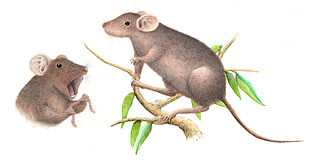
Sus is the genus of wild and domestic pigs, within the even-toed ungulate family Suidae. Sus include domestic pigs and their ancestor, the common Eurasian wild boar, along with other species. Sus species, like all suids, are native to the Eurasian and African continents, ranging from Europe to the Pacific islands. Suids other than the pig are the babirusa of Indonesia, the pygmy hog of South Asia, the warthogs of Africa, and other pig genera from Africa. The suids are a sister clade to peccaries.

The tamaraw or Mindoro dwarf buffalo is a small hoofed mammal belonging to the family Bovidae. It is endemic to the island of Mindoro in the Philippines, and is the only endemic Philippine bovine. It is believed, however, to have once also thrived on the larger island of Luzon. The tamaraw was originally found all over Mindoro, from sea level up to the mountains, but because of human habitation, hunting, and logging, it is now restricted to only a few remote grassy plains and is now a critically endangered species.

Palawan is the largest island of the province of Palawan in the Philippines and fifth-largest by area and tenth-most populous island of the country, with a total population of 994,101 as of 2020 census. The north west coast of the island is along the South China Sea, while the south east coast forms part of the northern limit of the Sulu Sea. Much of the island remains traditional and is considered by some as under-developed. Abundant wildlife, jungle mountains, and some white sandy beaches attract many tourists, as well as international companies looking for development opportunities.

The babirusas, also called deer-pigs, are a genus, Babyrousa, in the swine family found in the Indonesian islands of Sulawesi, Togian, Sula and Buru. All members of this genus were considered part of a single species until 2002, the babirusa, B. babyrussa, but following that was split into several species. This scientific name is restricted to the Buru babirusa from Buru and Sula, whereas the best-known species, the north Sulawesi babirusa, is named B. celebensis. The remarkable "prehistoric" appearance of these mammals is largely due to the prominent upwards incurving canine tusks of the males, which actually pierce the flesh in the snout.

Looc, officially the Municipality of Looc, is a 5th class municipality in the province of Occidental Mindoro, Philippines. According to the 2020 census, it has a population of 7,802 people.

Lubang, officially the Municipality of Lubang, is a 4th class municipality in the province of Occidental Mindoro, Philippines. According to the 2020 census, it has a population of 17,437 people.

Paradoxurus is a genus of three palm civets within the viverrid family that was denominated and first described by Frédéric Cuvier in 1822. The Paradoxurus species have a broad head, a narrow muzzle with a large rhinarium that is deeply sulcate in the middle. Their large ears are rounded at the tip. The tail is nearly as long as the head and body.

The Visayan spotted deer, also known as the Visayan deer, the Philippine spotted deer or Prince Alfred's deer, is a nocturnal and endangered species of deer located primarily in the rainforests of the Visayan islands of Panay and Negros though it once roamed other islands such as Cebu, Guimaras, Leyte, Masbate, and Samar. It is one of three endemic deer species in the Philippines, although it was not recognized as a separate species until 1983. An estimated 2,500 mature individuals survived worldwide as of 1996, according to the IUCN, although it is uncertain of how many of them still survive in the wild. The diet of the deer, which consists of a variety of different types of grasses, leaves, and buds within the forest, is the primary indicator of its habitat. Since 1991 the range of the species has severely decreased and is now almost co-extensive with that of the Visayan warty pig.

The pygmy hog is the rarest species of pig in the world today. It is a suid native to alluvial grasslands in the foothills of the Himalayas at elevations of up to 300 m (980 ft). Today, the only known population lives in Assam, India and possibly southern Bhutan. As the population is estimated at less than 250 mature individuals, it is listed as Endangered on the IUCN Red List. It is the only species in genus Porcula.

The Bornean bearded pig, also known as the Sunda bearded pig or simply bearded pig, is a species in the pig genus, Sus.

The Visayan warty pig is a critically endangered species in the pig genus (Sus). It is endemic to six of the Visayan Islands in the central Philippines. It is known by many names in the region with most translating into 'wild pig': baboy ilahas, baboy talonon, baboy sulop, and baboy ramo.

The Philippine warty pig is one of four known species in the pig genus (Sus) endemic to the Philippines. The other three endemic species are the Visayan warty pig, Mindoro warty pig and the Palawan bearded pig, also being rare members of the family Suidae. Philippine warty pigs have two pairs of warts, with a tuft of hair extending outwards from the warts closest to the jaw. It has multiple native common names, but it is most widely known as baboy damo in Tagalog.

The Celebes warty pig, also called Sulawesi warty pig or Sulawesi pig, is a species in the pig genus (Sus) that lives on Sulawesi in Indonesia. It survives in most habitats and can live in altitudes of up to 2,500 m (8,000 ft). It has been domesticated and introduced to a number of other islands in Indonesia.

The large Mindoro forest mouse is a species of rodent in the family Muridae, from the genus Apomys. It is found only in the Philippines. Its natural habitat is subtropical or tropical moist montane forests. It is a large mouse with large feet, a long tail and an elongated snout which is morphologically unique within its genus. It is covered in soft fur which is mostly dark brown in colour. Its closest relative is thought to be the Luzon montane forest mouse, based on genetic and morphological similarities.

The Javan warty pig, also called Javan wild pig, is an even-toed ungulate in the family Suidae. It is endemic to the Indonesian islands Java and Bawean, and is considered extinct on Madura. It is listed as Endangered on the IUCN Red List since 1996.
The Philippines has four endemic types of species of wild pigs. This makes the Philippines unique in having arguably the largest number of endemic wild pigs. Two separate populations of unstudied wild pig species have been reported on the islands of Tawi-Tawi, and Tablas.

The Palawan bearded pig is a pig species in the genus Sus endemic to the Philippines, where it occurs on the archipelago of islands formed by Balabac, Palawan, and the Calamian Islands. It is 1 to 1.6 m in length, about 1 m (3.3 ft) tall and weigh up to 150 kg (330 lb).
Leticia "Letty" E. Afuang is a Filipina biologist and wildlife conservationist currently working as a professor under the Animal Biology Division of the Institute of Biological Sciences (IBS) at the University of the Philippines Los Baños (UPLB), located in the Philippine province of Laguna. She is also one of the main curators for the Zoological and Wildlife Collection at the UPLB Museum of Natural History. While known as the "Snake Lady," her research as a herpetologist also focuses on other reptiles, amphibians and a wide array of herpetofauna across the Philippine islands. As an advocate for environmental sustainability, she has founded multiple organizations such as the Mindoro Biodiversity Conservation Foundation and the Biodiversity Conservation Society of the Philippines.

















